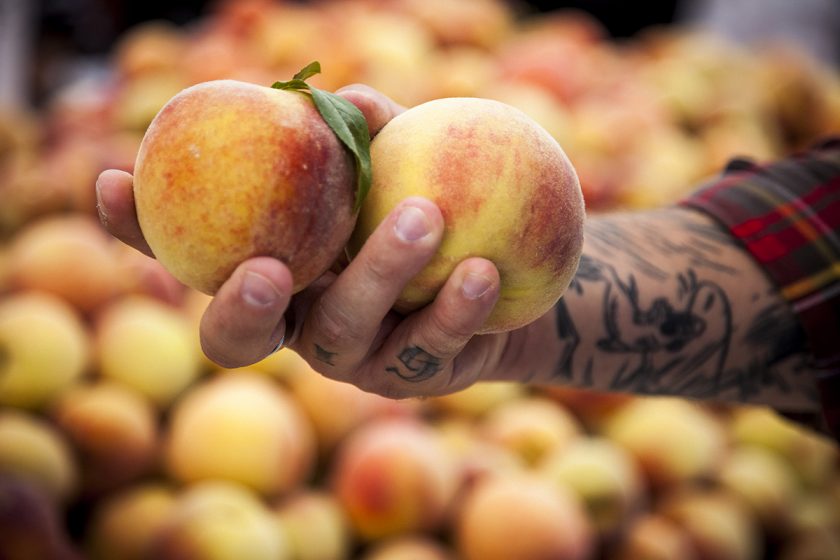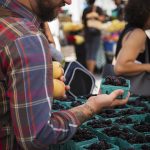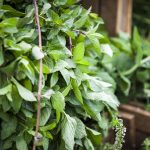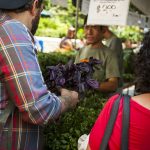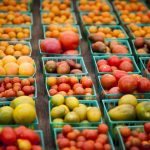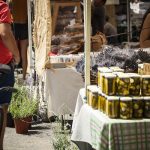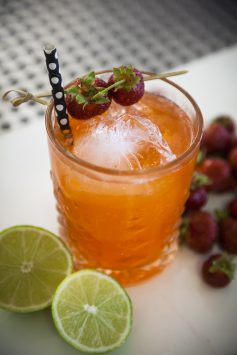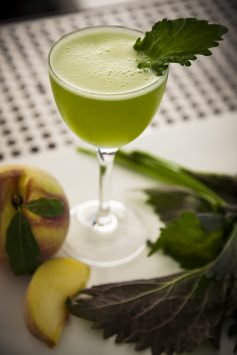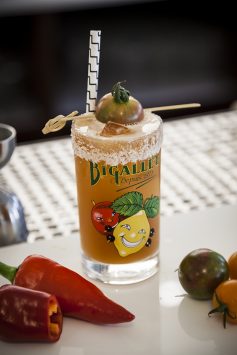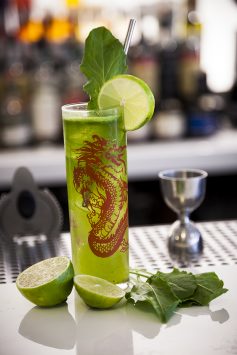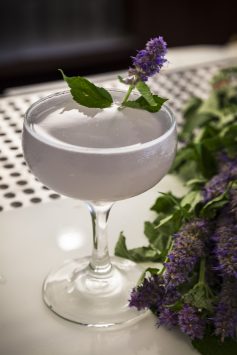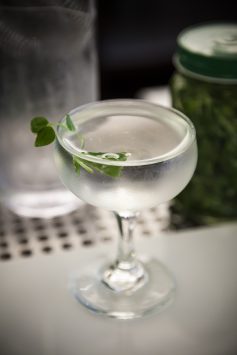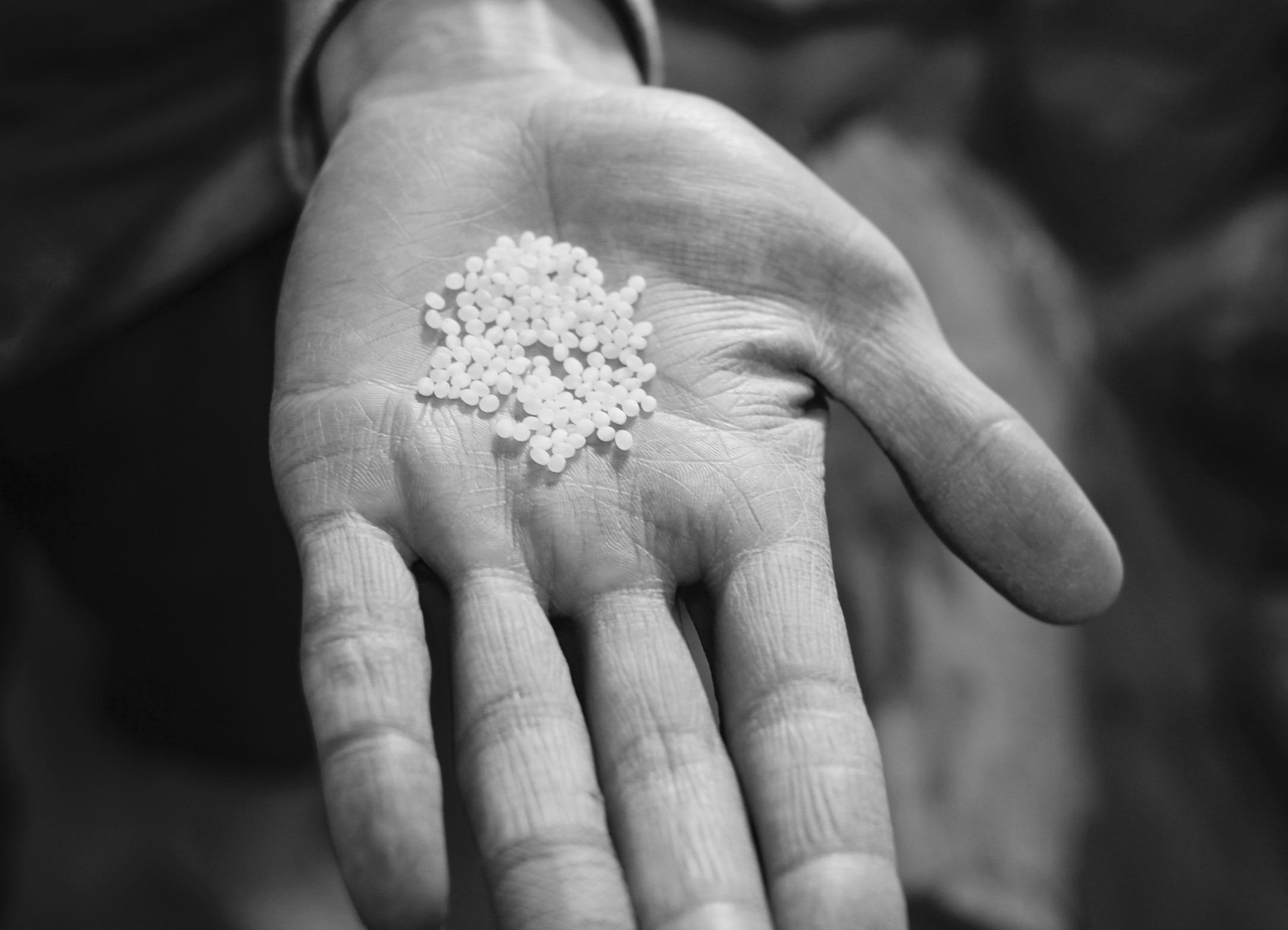As we enter the proverbial “dog days” of summer, and the heat on the pavement seems to amplify the humidity in the air until we’re nearly drowning in our own sweat, well… what we’re trying to say is, we could use a cool, refreshing drink. Thankfully, the tail end of summer brings us much more than just oppressive heat; now is the time when all the fruits and veggies that have been building their energy all season long are ready to burst into song! There is no better time to visit the Farmer’s Market. The berries are beautiful, the peppers are popping, the melons are swelling and the tomatoes are ripe, red and juicy. It’s no wonder the greenmarkets are as full of people snapping pictures as of people buying produce; this is the bounty of local nature at its peak.
And alongside all those cameras and customers are the chefs – kitchens look forward with passionate anticipation each year to this very moment, and the inspiration it brings. The markets are bursting with possibility and flavor, everything fresh and alive and ready to shine in a brand new recipe. But the love need not stop there – nearly everything that’s coming up rosy right now has just as welcome a home in our summer cocktails as it does on our summer dining table. The greenmarket is a tremendous source of inspiration to all kinds of drinkmakers, from world-class mixologists to beginning home bartenders. Have you seen the blackberries right now? Who wouldn’t want to put those in a drink?? (Don’t worry, we’ll give you an easy recipe.)
So let’s talk about some of the ways to do that – some methods for incorporating fresh, local, greenmarket produce into your end-of-summer cocktails. We’ll give you an example recipe for each technique, but the crucial thing here is to consider the methods themselves, so that when you go visit the market you can find your own inspiration and try out a new ingredient on your own!
Ready? Good. Let’s go.
As a greenmarket cocktailian, we recommend you keep your eyes out most of all for fresh fruits and herbs to play with. Savory veggies can also be fun, but can be a bigger challenge. We’ll try a couple later, but remember that fruits and herbs are the easiest ingredients to take from farm to glass. (You can also have a lot of fun making drinks with local preserves, of course, but let’s save those for the winter – because, you know, they’re preserves. That’s the whole idea.) We’ll cover three basic methods of incorporating these ingredients into your drinks: muddling, syrups and infusions.
MUDDLING
Muddling herbs or berries into your drink is obviously the easiest way to mix a fresh ingredient into your cup. It doesn’t really get simpler : smash, smash, smash… right? Yes, of course, essentially – but we’re here to tell you that there can be some technique to consider here, too.
First of all, think about what you’re muddling, and how it will change the drink.
Is it juicy, like a berry or a watermelon? If so, that might dilute your cocktail a little more, and berries or citrus may have their own acid which will change the texture of the drink, too. Do you want the oils in the leaves or the peel, or the sugar in the flesh of the fruit? Try to avoid stems, seeds pith and roots – these will carry a strong bitter note with them. Maybe most of all, consider what happens to the produce when you muddle it: if you pulverize some raspberries into your drink, you’ve released juice and sugar and everyone’s happy – but if you go to town on some delicate mint leaves, you’ll smash their veins open and a bitter, tannic vegetal note will enter the drink. With most muddled ingredients, try to work gently, with love. Gently press them into releasing their oils and flavors, don’t batter them into oblivion. The love you bring to your muddling will show clearly in the cocktail you wind up with. If you’ve ever had an over-muddled mojito, you know just what I mean.
We prefer to muddle those ingredients that will stand a little smashing – berries, tomatoes, citrus peels – and a lot of classic cocktails still call for a bit of ol’ mortar and pestle action. A seasonal favorite that’s also deeply versatile is a Bramble. Blackberries and lemon go a long way together, and it’s easy to substitute the base spirit for your favorite tipple without worry of ruining the drink.
A slightly more unique muddled drink, though, is this fruit-forward aperitif – a porch friendly offering that should roll kick off any party with delight. Strawberries and tequila love each other in ways we’ll never fully understand (but we’ll do our best to research the matter fully); meanwhile, the beautiful, rosy bite of Contratto Bitter brings a backbone to the proceedings, almost like the crunch of a strawberry seed between your teeth.
COMPANY B
- 1.5 oz Azteca Azul Blanco Tequila
- .5 oz Contratto Bitter
- .5 oz Giffard Curaçao Triple Sec
- .5 oz fresh lemon juice
- .25 oz agave nectar
- 1-2 pc strawberries
Muddle strawberries in mixing tin with the agave ; add remaining ingredients ; shake ; strain over ice into a short glass, or fine strain into a chilled cocktail glass ; garnish with a slice of fresh strawberry
The above recipe can easily accept the heavy-handed method of muddling, but let’s also explore the gentler approach that gives a little love to those delicate herbs. A recent darling of the kitchen and cocktail set, shiso is a leafy green Asian herb with high, floral aromatics and an unmistakable brightness; we’ve fallen in love with having it in dishes paired with peaches or with Matcha green tea powder, and dropping huge handfuls in our summertime pho. Local farms have been growing it in spades lately, and thankfully peaches just came into season with a vengeance, so we’re in luck! We buy our peaches in Union Square Greenmarket from Caradonna Farms, and our shiso from Neversink Farm, which is also serendipitous… because another favorite pairing for shiso is apple, and the freshness of Neversink Distillery’s local New York State apple brandy is a snappy, delicious way to achieve it. This easy recipe takes just a tiny bit of prep for a brilliantly refreshing summer sip that seems to evoke all its disparate parts (peach, shiso, matcha) while ultimately replicating the most delicious Grannysmith of all time…
SECOND STORY
- 2oz Neversink Apple Brandy
- 1 oz fresh lime juice
- .5 oz matcha syrup*
- 2 pc shiso leaf
- 1 pc peach wedge
Gently muddle shiso with peach in a mixing tin ; add remaining ingredients & ice ; shake ; fine strain into a chilled cocktail glass ; garnish with a shiso leaf
*To make matcha syrup, combine equal parts matcha green tea powder with water, stirring until fully integrated. Separately, make a rich simple syrup (2:1, two parts sugar to one part water) on low heat, stirring until fully integrated…. Remove from heat and cool. After syrup has cooled, combine equal parts matcha water and rich simple syrup, stirring again until integrated. Voila!
If there’s one drink that springs to mind when strolling through the cornucopia of local farms, it is of course the Bloody Mary. The sea of tomatoes at some farm stands seems to be simply begging for it. And you should do it. Gather basil leaves, horseradish, hot peppers and tomatoes and go to town! (Try your bloody with a little Del Bac Mesquite Whiskey or Brennivin Aquavit – trust us, they’re both next level Mary mixers….) But there are other fun things to be done with tomato, and muddling is almost as good as a Bloody mix that’s been through the blender.
A tribute to the meeting of old worlds and new that happens every day in the ancient French restaurants and Italian neighborhoods of New York, this is also one of our favorite tomato tipples. It’s a versatile recipe; try adding basil, sage, oregano, or chili peppers to your taste. Our favorite twist is to add barspoon of Bigallet Thym Liqueur to the mix as well…
SMITH STREET SOUR no.2
- 1.5oz Agave de Cortes Mezcal Joven
- .5oz Bigallet Amer
- .75oz balsamic reduction*
- .5oz fresh lime juice
- 4 pc cherry tomatoes
Muddle tomatoes gently in a mixing tin ; add remaining ingredients & ice ; shake with vigor ; fine strain over ice in a rocks glass with ½ salt or chili-salt rim ; garnish with cherry tomato skewer
*To make balsamic syrup, combine 3 cups turbinado sugar (or sugar in the raw) with 1 cup water in a saucepan over low heat. Stir constantly to prevent the sugar from burning. In another saucepan, bring 3 cups of balsamic vinegar to a low simmer. When sugar is completely dissolved, add the simmering vinegar slowly and carefully, wearing oven mitts. Watch out! The vinegar syrup will pop on the stove-top, and can burn badly! Stir for a few more minutes to combine fully, then chill. Kept cold, the remaining syrup will last for months, and makes a delicious addition to all kinds of dessert ideas.
SYRUPS
The trouble with muddling is, it’s not always consistent. There are a lot of variables involved: how we muddle, how our produce is before muddling, all of it. Our remaining methods of incorporating fresh produce into cocktails mitigate these concerns by making larger amounts of a consistent ingredients to mix into drinks. The most obvious (and most cost-effective) method is by making syrups.
Most syrups are made by heating sugar and water together and stirring or otherwise manipulating them until they are fully integrated together. This is a great baseline, but if we cook most of these fresh ingredients we’ll boil off some of the bright color and flavor that makes them so special. For greenmarket syrups, we typically prefer a cold syrup production method.
First, make a simple syrup by combining (1:1) equal parts sugar and water over a low heat, and stirring until the sugar is all dissolved. Remove the syrup from heat and chill it. Once it’s nice and cool, you’re ready for step two. Combine roughly ½ the amount by volume of fresh produce and simple syrup in a blender and buzz until smooth, then filter the sloppy result through a fine mesh sieve. For example, to make the green, tart, chlorophyll-rich syrup listed below in the Sorrel Collins, combine approx. 1 pint of fresh sorrel leaves with 1 quart of simple syrup. Then puree it and push it through the strainer. You’ll wind up with a bright green, sweet, tart syrup that almost seems too healthy for a cocktail. Almost.
NOTE: Always save some chilled syrup and your other ingredient on the side, just in case you need to tweak the taste of your syrup one way or the other. Fresh produce can vary dramatically.
SORREL COLLINS
- 2 oz Greenhook Ginsmiths American Dry Gin
- .75 oz sorrel syrup (see above)
- .5oz fresh lemon juice
Combine ingredients in a mixing tin ; add ice & shake ; strain over fresh ice into Collins glass ; top with soda and garnish with a leaf of sorrel and a wheel of lemon
Farm-fresh ingredients, like flowers, have been finding their way into historic cocktails for a long time. We’ve often been limited, though, in the bouquet we could apply to our beverages; roses and violettes were the only petals to get pushed into higher proof. But making our own syrups can expand those horizons.
Consider the bold, floral notes of the beautiful purple flowers that litter the farmer’s market throughout the summer. No, not lavender! The other purple flower, the one with the faint note of licorice in the finish: anise hyssop! Making an anise hyssop syrup is simple; repeat the method above, but due to anise hyssop’s powerful flavor, use only about 1 Tbsp of purple hyssop leaves per pint of simple syrup. Be careful to avoid the stem! (We sourced our fresh hyssop from Tamarack Hollow Farm from Plainfield, Vermont.) Alternatively, if you have dried hyssop (OK, or lavender, fiiiiiine), you can always make a similar syrup by adding the dried flowers to the initial syrup when it’s hot and allowing it to steep, like a sugar tea.
However you make it, the recipe below (a play on two classic Violette cocktails, the Water Lily and the Arsenic & Old Lace) will suit it beautifully.
HYSSOP & HEMLOCK
- 1.5 oz Chateau de Pellehaut Blanche d’Armagnac
- .75 oz Giffard Curaçao Triple Sec
- .75 oz fresh lemon juice
- .5 oz anise hyssop syrup
- 2 dashes absinthe
Combine ingredients in mixing tin ; add ice & shake ; strain into chilled cocktail glass ; garnish with sprig of anise hyssop
INFUSION
Probably the most fun way to incorporate farmers market spoils is through spirit infusion – the end result can be delicious, is generally shelf-stable, and even makes a great gift. But there’s also potential to screw an infusion up, and the results can be disgusting, expensive and even dangerous. Before we commit your new bottle of Medley Brothers Bourbon to that locally raised thick-cut bacon, let’s talk a little about what to do (and what not to do).
First of all, start slow – with fruits, veggies and herbs. They’re hard enough, and you’ll want to master that before you try anything dense with oils and proteins, like meats and nuts. There will always be a small trial and error process, so at first we recommend trying small amounts so you’re not wasting too much produce or spirit if something goes wrong.
Basically, to infuse ingredients into spirits, choose complimentary spirits (try dried cherries into brandy, peaches into whiskey, peppers into mezcal… you get the idea) then prepare your produce. If you’re working with veggies, chop them up fine to expose the delicate sugars inside them and maximize their surface area. If you’re working with dried fruit (generally far better than fresh, since fresh fruit has juice while dried fruit has concentrated sugars), break them open and expose their tender insides to the alcohol. If you’re working with hot peppers, consider the heat of the pith and seeds and maybe leave some out. Remove bitter skins, seeds and stems to focus on the freshest flavors. What you’re after here is bonding sugars and fats (oils) in produce with the sugars and acid chains in the alcohol; act accordingly.
Control is key. Don’t just fill a big jar with hot peppers or berries and dump in spirits, then pour out of it willy nilly until it’s gone. The infusion process should yield a delicious finished product which you can strain, removing the solid produce but leaving flavor behind, which allows for consistency and stability. If you left peppers in forever, at some point the heat will overpower the flavor; if you left berries in forever, at some point you’re drinking more juice than liquor.
Taste as you go. Most herbs, for example, will continue to build in intensity in the spirit, but there’s a moment of diminishing returns when the flavor peaks and then begins to oxidize and become bitter and tannic. This moment varies depending on the herb, of course, but typically a few days is the most you want to leave your raw ingredients soaking. When the flavor is full and powerful, pull the solids and re-bottle your infused booze.
Fruits and vegetables are generally more accommodating. Peeled cucumbers will continue to infuse beautifully into gin for weeks, and most dried fruit will only improve in depth of flavor with age. Still, at some point it’s always time to pull the solids and enjoy the fruits *ahem* of your labor. And never let jalapenos sit in tequila for more than 24 hours!
A seasonal favorite of ours is the infusion of pea shoots into vodka. This nearly neutral spirit is an ideal canvas for painting any flavors you can imagine, and sweet pea is a distinctive and delicious addition to a classic martini recipe.
To make a pea shoot infusion, snap about 1 cup of loose pea shoots in half, preparing their stems breathe the liquor in deeply; in a jar, combine them a clean, clear vodka like Helix and seal for one week. When home-infusing, always keep your work-in-progress away from heat sources and out of direct sunlight. Ideally, store it in a cool dark place, letting it rest and do the work of bonding. Finally, strain the solids out, grab a bottle of vermouth (we actually prefer a sweeter vermouth blanc here, to help mimic the soft sweetness of a fresh pea) and stir up a garden-fresh bracer to make PG Wodehouse and Alice Waters equally pleased.
SWEET PEA MARTINI
- 2 oz Pea Shoot Infused Helix Vodka
- 1 oz Routin Vermouth Blanc
- 1 dash absinthe (optional)
Combine ingredients in a mixing glass ; add ice & stir ; strain into chilled cocktail glass ; garnish with a fresh pea shoot sprig and a general sense of wellbeing
Good luck! We hope this serves as a good source of inspiration to start your own greenmarket cocktailing – let us know what works out well and come share with us!
Cheers!




